|
|
|
Sort Order |
|
|
|
Items / Page
|
|
|
|
|
|
|
| Srl | Item |
| 1 |
ID:
160478
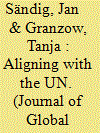

|
|
|
|
|
| Summary/Abstract |
Self-determination campaigns in the Global South have often been pursued through warfare. Since the 1990s, however, an increasing number of such movements have endorsed legalistic mechanisms of international law and the UN's core principle of nonviolence. We introduce the concept of UN-aligned self-determination movements for them. As a starting point to explain their occurrence, we examine two major cases: The Peaceful Southern Movement (Hirak) in Yemen and the Movement for the Actualization of the Sovereign State of Biafra (MASSOB) in contemporary Nigeria. Our analysis combines theories on political opportunities, diffusion, and framing from social movement, civil resistance, and armed rebellion research. We observe that since the end of the Cold War the rule of law, role of the UN, and norms of nonviolent conflict resolution have been strengthened in the international system. We argue that this has given self-determination movements in the Global South new opportunities for claims-making: Facing repressive governments, the leaders of Hirak and MASSOB have successfully aligned their movements with the UN by diffusing its core principles to the local struggle through resonant collective action frames. Thereby, our study contributes to understanding the diffusion of nonviolence in the international system, in particular in self-determination campaigns, and directs attention to the rise of UN-aligned self-determination movements.
|
|
|
|
|
|
|
|
|
|
|
|
|
|
|
|
| 2 |
ID:
160480
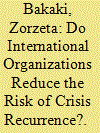

|
|
|
|
|
| Summary/Abstract |
This paper examines the effect of international organizations (IOs) on the recurrence of international crises. In line with existing literature on conflict onset, I suggest that country-dyads with more co-memberships in IOs have a lower probability of fighting again. Moving beyond this claim, however, I argue that the scope and mandate of the IO are not relevant for the risk of crisis recurrence. Ultimately, all types of IOs promote links between states and strengthen their chances for effective international cooperation. Empirically, I examine the probability of crisis recurrence between 1950 and 2008, using the count of dyadic co-memberships as the main explanatory variable. The results show that co-membership in any type of IO has negative and significant impact on crisis recurrence. Moreover, the disaggregation of IOs into different categories (e.g., those dedicated to conflict prevention, peace-brokering, or security) also points to a negative effect. The effects of IOs disaggregated by type, however, are not significantly different from the overall IO impact.
|
|
|
|
|
|
|
|
|
|
|
|
|
|
|
|
| 3 |
ID:
160474
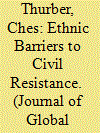

|
|
|
|
|
| Summary/Abstract |
While ethnic cleavages have featured prominently in our understanding of civil wars, attention to ethnic and social structures has been surprisingly absent from the recent wave of research on civil resistance. Yet these structures likely have an important impact on when and where we see nonviolent campaigns occur. This article argues that the strategic logic of civil resistance presents high barriers to entry for politically excluded ethnic minorities. Constraints on these groups’ ability to activate mechanisms central to an exclusively nonviolent strategy either prevent them from getting a civil resistance campaign off the ground or deter them from ever attempting to do so. Using original data on the ethnic composition of nonviolent and violent campaigns, I show that nonviolent campaigns are less likely than violent ones to include participants from politically disadvantaged ethnic groups and also less likely to feature ethnic political claims. Furthermore, I find that political exclusion and small group size reduce the likelihood that members of an ethnic group will initiate a campaign of civil resistance.
|
|
|
|
|
|
|
|
|
|
|
|
|
|
|
|
| 4 |
ID:
160473
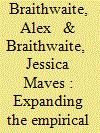

|
|
|
|
|
| Summary/Abstract |
This article introduces a special issue of Journal of Global Security Studies on advances in the disaggregated study of actors and tactics in nonviolent civil resistance campaigns. We initially discuss the recent rise of empirical, primarily quantitative research on nonviolence and civil resistance. We then note that the latest innovations in this literature are providing a disaggregated perspective on the actors engaging in nonviolence, as well as the tactics that they employ in doing so. In many respects, this direction parallels that taken in the study of civil wars over the past two decades. At the heart of this evolution in the research agenda on nonviolence is the availability of new, more nuanced data. The five articles in this issue very neatly demonstrate best practices in asking compelling research questions, deriving nontrivial hypotheses, and providing new data on the disaggregated nature of campaigns of nonviolent resistance.
|
|
|
|
|
|
|
|
|
|
|
|
|
|
|
|
| 5 |
ID:
160475
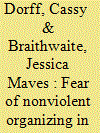

|
|
|
|
|
| Summary/Abstract |
What drives perceptions of fear regarding nonviolent mobilization? We investigate whether this fear is more acute in certain segments of society, or whether such concerns are randomly distributed across the population. We anticipate that civilians living in proximity to armed resistance groups are especially afraid of being targeted if they organize nonviolently against insecurity in their community. Using original survey data from Mexico in early 2014, we examine civilian perceptions of risk associated with nonviolent action. Quantitative analyses provide support for our expectation that civilians living in proximity to armed vigilante groups are more fearful of participating in nonviolent action. This suggests that organizers of civil resistance in Mexico (and similar conflict environments) would do well to consider the challenges posed by civilian vigilantism when seeking to mobilize civilians and selecting specific nonviolent strategies for high-risk constituencies.
|
|
|
|
|
|
|
|
|
|
|
|
|
|
|
|
| 6 |
ID:
160481


|
|
|
|
|
| Summary/Abstract |
How does maintaining international primacy affect a hegemon's domestic political economy? Debates on hierarchy, retrenchment, and structural power in the global economy are dominating international relations, yet scholars pay limited attention to the second-image reversed consequences of America's global role. The three books under review begin to correct this deficit. Combining their insights uncovers the effects of power politics on an area of substantial public and academic interest: economic inequality. While rising inequality is surely a multicausal outcome, research across the social sciences pinpoints technological change and the financialization of the American economy as fundamental drivers of the recent “redistribution.” These two shifts are generally treated as exogenous shocks in our models; the causal logics of the works under review illustrate that hegemony is the underlying, endogenous force. The analysis indicates a need for political scientists to study the interaction of international and domestic politics as a dynamic process, which would be bolstered by borrowing historical institutionalism's analytic toolkit. Investigating feedback loops and sequencing across both levels of analysis and across issue areas that are currently studied in isolation indicates an agenda that will better integrate security and political economy scholarship.
|
|
|
|
|
|
|
|
|
|
|
|
|
|
|
|
| 7 |
ID:
160472
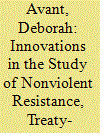

|
|
|
|
|
| Summary/Abstract |
The third issue of JoGSS’ third volume opens with a special, guest-edited section introducing new ways to explore nonviolent resistance—a form of conflict in which unarmed persons use a wide variety of coordinated tactics to push for change without harming others. As Braithwaite and Braithwaite note in their introduction to the special section, the quantitative study of nonviolent resistance has recently become much more prominent in the field. They curated for this issue a series of new studies that disaggregate actors and tactics to uncover new insights regarding the role of ethnic power relations on the participant bases of nonviolent and violent resistance campaigns, the role of fear of victimization in patterns of mobilization, the effects of state response in protest dynamics, the role of national trade unions in the duration and outcomes of nonviolent campaigns, and the role of the United Nations in the diffusion of norms of nonviolence across secessionist movements.
|
|
|
|
|
|
|
|
|
|
|
|
|
|
|
|
| 8 |
ID:
160477
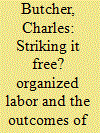

|
|
|
|
|
| Summary/Abstract |
This study draws from organizational theory to explain the outcomes of civil resistance campaigns. Organizational theory suggests that organizations embedded in extensive interpersonal networks upon which the state partially depends bring “leverage” to civil resistance campaigns and increase the likelihood of major government concessions in the short term. Also, organizations with strong local ties and a confederal “national” structure should bring resilience and reduce the probability of short term failure. We argue that, in general, National Trade Unions (NTUs) approximate these organizational features. Using new data on the participation of NTUs in civil resistance campaigns, our results suggest that NTU participation increases the likelihood of short-term success and decreases the chances of short-term failure. NTU participation also improves the prospects of postconflict democratization. In contrast, campaign size is robustly associated with short-term success but not with the probability of failure or postconflict democratization. Our research suggests that an “organizational” turn is a productive step toward understanding the short- and long-term outcomes of nonviolent campaigns.
|
|
|
|
|
|
|
|
|
|
|
|
|
|
|
|
| 9 |
ID:
160476
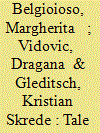

|
|
|
|
|
| Summary/Abstract |
Bosnia and Herzegovina (BiH) experienced an unprecedented wave of nonsectarian antigovernment protests in 2014. Although the key motivating factors generally highlighted, such as economic marginalization and poor governance, were common throughout Bosnia and Herzegovina, the protests did not extend to all parts of the country. Notably, despite very similar initial conditions in the two jurisdictions of the country, the Federation of Bosnia and Herzegovina (FBiH) saw major unrest with a large number of participants in many locations while subsequent protest mobilization was much more limited in the Republic of Srpska (RS). We take advantage of the variation in the responses from the two governments in the same country to evaluate how observed and anticipated government responses can shape the willingness to join dissident activity. We argue that variation in government responses and its impact on perceptions of prospects for successful collective action can help account for the differences in mobilization across the two entities. We test our expectations using a new data set on protest events, participants, and government responses in BiH from January to April 2014. Our findings are consistent with the argument that coherent repressive government policies tend to suppress mobilization, while mixes of repressive responses and concessions from the government can encourage further mobilization. The results for FBiH show clear variation in protest following changes in government behavior and are consistent with the claim that repressive responses likely suppressed mobilization in the RS.
|
|
|
|
|
|
|
|
|
|
|
|
|
|
|
|
| 10 |
ID:
160479


|
|
|
|
|
| Summary/Abstract |
Multilateral treaty-making is a venerable tool for navigating a sovereignty-constrained world. But that is not all; it is also a taken-for-granted practice of the international system, constitutive of both state actors and the international system itself. Constitutive practices are meaningful social actions that serve to circumscribe thought and action in the social world, delineating and in part generating both agents and the system in which they operate. Multilateral treaty-making is one such practice. While states make treaties, so too does treaty-making make states. Multilateral treaty-making can and does serve the instrumental interests of states, but exploring the constitutive nature of treaty-making is an inquiry into the foundations upon which those instrumental calculations are made—why have states turned to this practice in pursuit of their interests? In this article we provide a mixed-method approach to observing the constitutive dynamics described by practice theory that have thus far proven relatively elusive to capture empirically. In so doing our inquiry provides a fuller understanding of a foundation of competent statehood and of the international system in which states operate.
|
|
|
|
|
|
|
|
|
|
|
|
|
|
|
|
|
|
|
|
|